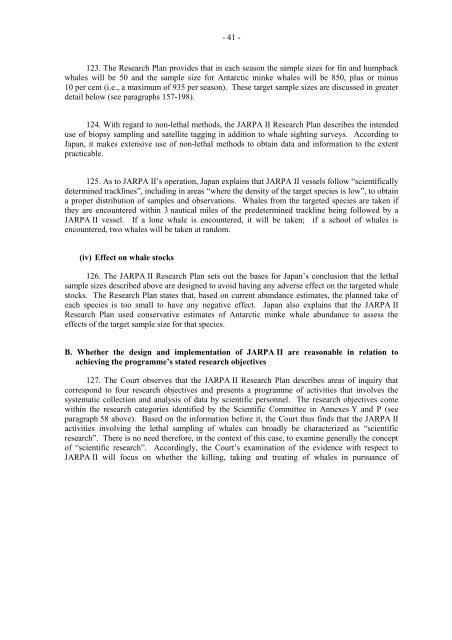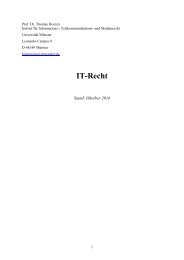3d4yVkKMl
3d4yVkKMl
3d4yVkKMl
Create successful ePaper yourself
Turn your PDF publications into a flip-book with our unique Google optimized e-Paper software.
- 41 -<br />
123. The Research Plan provides that in each season the sample sizes for fin and humpback<br />
whales will be 50 and the sample size for Antarctic minke whales will be 850, plus or minus<br />
10 per cent (i.e., a maximum of 935 per season). These target sample sizes are discussed in greater<br />
detail below (see paragraphs 157-198).<br />
124. With regard to non-lethal methods, the JARPA II Research Plan describes the intended<br />
use of biopsy sampling and satellite tagging in addition to whale sighting surveys. According to<br />
Japan, it makes extensive use of non-lethal methods to obtain data and information to the extent<br />
practicable.<br />
125. As to JARPA II’s operation, Japan explains that JARPA II vessels follow “scientifically<br />
determined tracklines”, including in areas “where the density of the target species is low”, to obtain<br />
a proper distribution of samples and observations. Whales from the targeted species are taken if<br />
they are encountered within 3 nautical miles of the predetermined trackline being followed by a<br />
JARPA II vessel. If a lone whale is encountered, it will be taken; if a school of whales is<br />
encountered, two whales will be taken at random.<br />
(iv) Effect on whale stocks<br />
126. The JARPA II Research Plan sets out the bases for Japan’s conclusion that the lethal<br />
sample sizes described above are designed to avoid having any adverse effect on the targeted whale<br />
stocks. The Research Plan states that, based on current abundance estimates, the planned take of<br />
each species is too small to have any negative effect. Japan also explains that the JARPA II<br />
Research Plan used conservative estimates of Antarctic minke whale abundance to assess the<br />
effects of the target sample size for that species.<br />
B. Whether the design and implementation of JARPA II are reasonable in relation to<br />
achieving the programme’s stated research objectives<br />
127. The Court observes that the JARPA II Research Plan describes areas of inquiry that<br />
correspond to four research objectives and presents a programme of activities that involves the<br />
systematic collection and analysis of data by scientific personnel. The research objectives come<br />
within the research categories identified by the Scientific Committee in Annexes Y and P (see<br />
paragraph 58 above). Based on the information before it, the Court thus finds that the JARPA II<br />
activities involving the lethal sampling of whales can broadly be characterized as “scientific<br />
research”. There is no need therefore, in the context of this case, to examine generally the concept<br />
of “scientific research”. Accordingly, the Court’s examination of the evidence with respect to<br />
JARPA II will focus on whether the killing, taking and treating of whales in pursuance of



